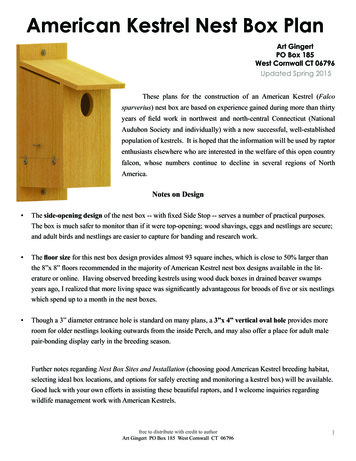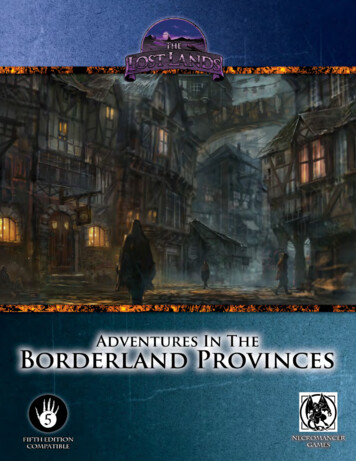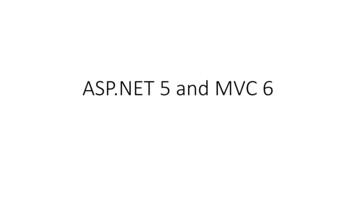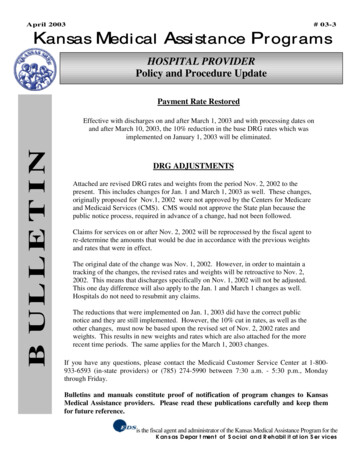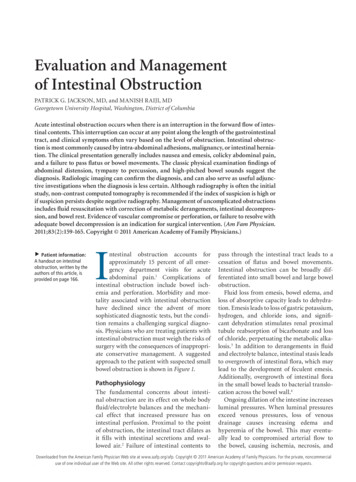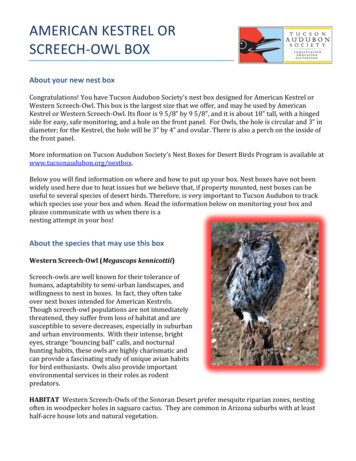
Transcription
AMERICAN KESTREL ORSCREECH-OWL BOXAbout your new nest boxCongratulations! You have Tucson Audubon Society’s nest box designed for American Kestrel orWestern Screech-Owl. This box is the largest size that we offer, and may be used by AmericanKestrel or Western Screech-Owl. Its floor is 9 5/8” by 9 5/8”, and it is about 18” tall, with a hingedside for easy, safe monitoring, and a hole on the front panel. For Owls, the hole is circular and 3” indiameter; for the Kestrel, the hole will be 3” by 4” and ovular. There is also a perch on the inside ofthe front panel.More information on Tucson Audubon Society’s Nest Boxes for Desert Birds Program is available atwww.tucsonaudubon.org/nestbox.Below you will find information on where and how to put up your box. Nest boxes have not beenwidely used here due to heat issues but we believe that, if property mounted, nest boxes can beuseful to several species of desert birds. Therefore, is very important to Tucson Audubon to trackwhich species use your box and when. Read the information below on monitoring your box andplease communicate with us when there is anesting attempt in your box!About the species that may use this boxWestern Screech-Owl (Megascops kennicottii)Screech-owls are well known for their tolerance ofhumans, adaptability to semi-urban landscapes, andwillingness to nest in boxes. In fact, they often takeover next boxes intended for American Kestrels.Though screech-owl populations are not immediatelythreatened, they suffer from loss of habitat and aresusceptible to severe decreases, especially in suburbanand urban environments. With their intense, brighteyes, strange “bouncing ball” calls, and nocturnalhunting habits, these owls are highly charismatic andcan provide a fascinating study of unique avian habitsfor bird enthusiasts. Owls also provide importantenvironmental services in their roles as rodentpredators.HABITAT Western Screech-Owls of the Sonoran Desert prefer mesquite riparian zones, nestingoften in woodpecker holes in saguaro cactus. They are common in Arizona suburbs with at leasthalf-acre house lots and natural vegetation.
BOX MOUNTING Boxes should be placed at least 10 feet high, though heights of 12 to 20 feet mayprove most successful.NESTING FACTS Courtship begins for screechowls as early as January and February, whenmale owls begin calling near their nest sites.Nests may be occupied by mid-March withfledglings present by mid-April. Peak breedingoccurs late April through late May. Nests may beoccupied into August. Three to five eggs areincubated for 33 or 34 days. Owlets may beobserved peering out of the nest hole about tendays prior to fledging. Screech-owls will protecttheir nests by “dive-bombing” humans, so boxmounting sites should be carefully considered.American Kestrel (Falco sparverius)The brightly colored American Kestrel is NorthAmerica’s smallest falcon, measuring just 8 to 10inches in length. Although formerly known as the sparrow hawk, kestrels feed primarily on insectsand small rodents. This fierce hunter adapts well to human-influenced habitats and urban settings,but the species’ population is declining in many regions of the United States, including Arizona.Tucson Bird Count data show a sharp reduction in numbers locally since 2010. Kestrels suffer fromhabitat loss and a lack of available nest cavities. Fortunately, this species readily accepts humancrafted nest boxes. Nest box programs are currently supporting the American Kestrel around thecountry. Watch for these birds perching on utility wires or hovering in the sky as they search forprey below. You may hear them calling: killy-killy-killy.HABITAT Kestrels prefer semi-open country of all kinds, especially with available hunting perchesproviding views of surrounding land. In the Sonoran Desert, kestrels frequently nest in flicker holesin saguaros. They also nest in urban and suburban palm trees, underneath untrimmed fronds.BOX MOUNTING Boxes should be placed between 10 and 20 feet high with a northern or easternorientation. They can be affixed to houses or other buildings. Boxes should not be placed amongdense trees or shrubs, though low, open vegetation is welcome.NESTING FACTS Kestrel pairs in Arizona deserts begin breeding in late winter. During courtship,the male often performs impressive feats of aerial display. As the time for egg-laying draws near,the male provides more and more of the female’s daily food. Kestrels lay eggs as early as March, butthe peak of the breeding season is in June. The birds use no nesting material, though eggs depositedon bare surfaces can sometimes lead to poor hatching and breakage. Kestrels occasionally producemore than one brood in a single year. They may return to reuse the same nests, year after year.During the winter, kestrels sometimes roost in nest boxes and cavities.Monitoring your nest box
We encourage you to let us know if birds use your box. If a nest is started, please register your boxat www.nestwatch.org and follow the instructions in the following monitoring document, which willshare your data with Tucson Audubon:Set Up A NestWatch AccountFollow this link: http://nestwatch.org/nw/join/tucsonaudubonIf you have a NestWatch account sign in. If not, click “Need an account?” and set up a NestWatchaccount.In NestWatch, Set up a Nest LocationTo set up a new nest location:1. At www.nestwatch.org, go to “Your Data” and click “Add New Nest Site”2. Type in an address close to where your nest box is located. Next, using the map, zoom in and drag the3.4.5.6.7.iconto the exact spot the nest box is located.Scroll down and fill out all the information about your nest box that you can. If you don’t know someof what they are asking, elevation above sea level for example, then you can just skip that question.If you are monitoring multiple nests then you can separate out the nests into groups by selection“Add this nest to groups.”Click save when you are finished. You can always come back to change or add more information tothis nest site later on.You cannot link this nest box to the Tucson Audubon Society until birds have attempted to nest in thebox.Once the nest site is saved, then continue to monitor the nest box regularly (minimum once a week)until you see birds (or other animals) attempting to nest.Occupied Nest:When monitoring, it you see that the nest box is occupied then take the following steps.1. Identify the occupant. If the occupant is not present then record the nest’s shape, what it is made ofand the number and appearance of eggs if they are present. The most important reason foridentifying the occupant quickly is so that invasive, unwanted species can be removed beforebecoming established. Non-native, invasive species, like House Sparrow and European Starling,compete for nesting spaces with our native species. Native species often need to be supportedbecause they are declining. Starlings and House Sparrows have adapted to most parts of the globewhere humans live, and do not need our help to survive.I.Use binoculars and a field guide to birds to try to identify adult birds that using a box. Consultthe Tucson Audubon Nature Shops if you need a field guide or binoculars.II.Nest identification help is available from NestWatch: ying-nests-and-eggs/. Bird identification help is found at NationalAudubon’s online field guide: http://www.audubon.org/bird-guide.III.This page shows European Starling and House Sparrow nest and egg rspar.htmIV.If you are having difficulty identifying a nest or bird you can take a picture of the bird, or thenest when the adults are gone. Send the photos to kkroesen@tucsonaudubon.org and we willtry to make the identification.2. If the nester is positively identified as an invasive or unwanted species such as a House Sparrow,European Starling, or non-bird, remove all nesting material. Continue to come back to the nest daily
to make sure they do not try to rebuild their nests. If unwanted birds repeatedly build nests despitebeing cleared out, then moving the nest box might be helpful.I.If you find a wasp or bee colony in your nest box, do not have any sort of pesticide sprayedinto the nest in order to remove it as this will poison any future bird residents.i. If you notice bees swarming (or clumped in a ball) around your nest box but theyhave not yet built their nest you can have the swarm removed through anenvironmentally friendly live bee trap. Find an environmentally-friendly bee removalexpert or contact one of the following companies:http://www.americanbeecontrol.net/, http://www.azpest.com/bee al-bee-removal/ii. If the bees or wasps have already built a nest then ABC American Bee Control (firstlink above) should be able to remove an established bee hive without using anyinsecticides or killing the bees. Some people “do it themselves” by waiting for a verycold morning when bees are inactive, and then plugging up the hive or covering it in aburlap sack then submerging it in water. However, it is best to assume that any honeybees in this region are Africanized—do not take chances unless you are sure of whatyou are doing.iii. Once the hive is cleared out then scrub the inside of the nest box with soap and waterso that future bees will not be attracted to it.iv. You can keep the nest box covered when it is not nesting season to prevent hives.II.If a mouse nests in your nest box then make sure to wear gloves and masks while removingthe nest to avoid hantavirus.III.If you find eggs or live young then make sure they are positively identified as pests beforeremoving and disposing of them (usually by dropping eggs on the ground some distance fromthe nest).- Laws in Arizona protect squirrels as non-game animals unless they arecausing damage. Therefore it would be recommended to leave live squirrelyoung alone. Try to remove any squirrel nests before they have young.NestWatch anaging-house-sparrows-andeuropean-starlings/3. If you identify your nester as a non-pest species then you are ready to log a nesting attempt into yourNestWatch account!Recording a Nesting Attempt:1. Sign into NestWatch and go to “Your Data” then click “Nest Site List.” If your nest box is not listed,follow the instructions above to add a nest site. Otherwise, find the correct nest side and click on“Add Attempt.”2. Record what species is nesting and under “Connect This Nest To a Community” select “TucsonAudubon Nest Boxes for Urban Birds Pilot Project”3. If you want to fill out the sheet by hand while in the field, you can print out this sheet fromNestWatch: taSheet 20120516 final.pdf4. Each time you monitor the nest fill out each section of the nest visit table which looks like this. If youthink that this table is too small or hard to read then you can switch over to “Change to Single EntryMode.”
5. For status and activity sections two letter codes are used to succinctly describe the status of the nest,adults and young. Click on the box and select the code that best describes the status and activity ofeach. (Ex: ba if adults are observed building a nest)6. If you are in the field you can find a list of codes and their descriptions on the print out mentionedabove. They are listed under breeding data on the second page.7. Cowbirds are parasitic birds that lay their eggs in other bird’s nests. If you find cowbird eggs in yournest you can remove them but make sure not to disturb the nest in the process. More informationabout cowbirds can be found here: brownheaded-cowbirds/8. You should not leave any blank spaces in the nest visit box and a new line should be filled out foreach time the nest box is monitored. You can put a “u” for unknown if you are unable to count eggsor young.9. If you noticed anything additional to what is covered in the table then record that in the notessection.10. Once you record all information for a visit then scroll down to the bottom of the page and click “SaveAll Data.”11. Do not fill out any nest summary information until all the young and adults have left or have died.
IV. If you are having difficulty identifying a nest or bird you can take a picture of the bird, or the nest when the adults are gone. Send the photos to kkroesen@tucsonaudubon.org and we will try to make the identification. 2. If the nester is positively identified as an invasive or u
